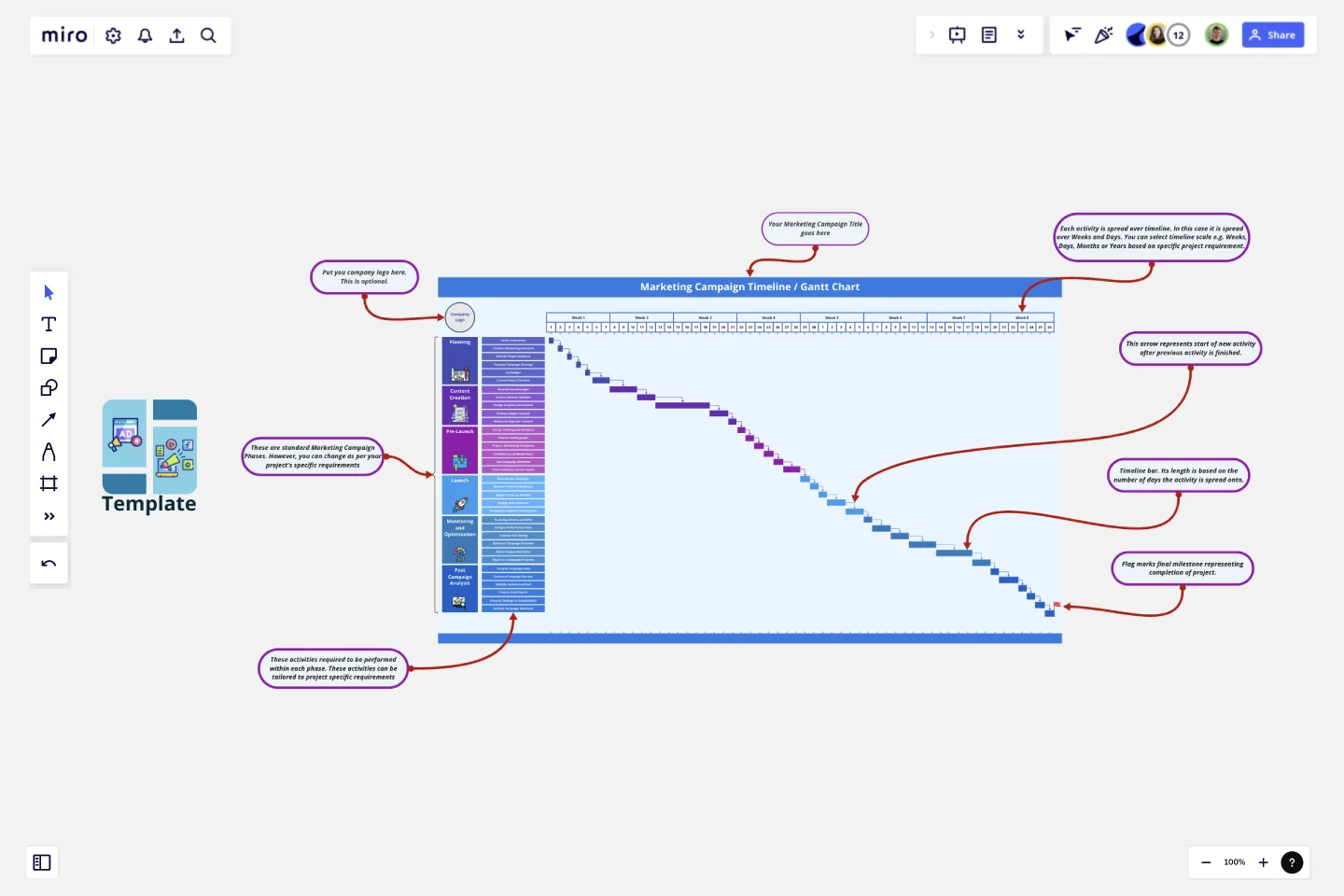Marketing Campaign Timeline
This Marketing Campaign Timeline/Gantt Chart template is meticulously designed to help you plan, execute, and analyze your marketing campaigns with precision and clarity.
The template is organized into six key stages: Planning, Content Creation, Pre-Launch, Launch, Monitoring & Optimization, and Post-Campaign Analysis. Each stage includes detailed sub-tasks to ensure a thorough and efficient campaign process. A filled example for a Social Media Marketing Campaign is provided to illustrate how to utilize the template effectively.
How to Use the Template
Review the Example: Start by examining the filled example for a Social Media Marketing Campaign to understand how each stage and sub-task is mapped out.
Customize for Your Campaign: Replace the example content with details specific to your marketing campaign. Adjust the stages, sub-tasks, and timelines according to your campaign’s needs.
Update Regularly: Keep the timeline updated with the latest progress and changes. Use the template to track each stage of the campaign and ensure all tasks are completed on time.
Communicate with the Team: Use the template to provide regular updates to your marketing team, ensuring everyone is informed about the status of the campaign and any adjustments that need to be made.
This template is a comprehensive tool designed to guide you through the entire marketing campaign lifecycle, ensuring a structured and effective approach to achieving your marketing goals.
This template was created by Khawaja Rizwan.
Get started with this template right now.
Annual Calendar Template
Works best for:
Business Management, Strategic Planning, Project Planning
Plenty of calendars help you focus on the day-to-day deadlines. With this one, it’s all about the big picture. Borrowing from the grid structure of 12-month wall calendars, this template shows you your projects, commitments, and goals one full year at a time. So you and your team can prepare to hunker down during busy periods, move things around as needed, and celebrate your progress. And getting started is so easy—just name your calendar’s color-coded streams and drag stickies onto the start date.
One Page Product Strategy
Works best for:
Product Management, Planning
The One Page Product Strategy template condenses complex product strategies into concise, actionable plans. By providing a structured framework for outlining goals, target markets, and key initiatives, this template enables product teams to align on strategic objectives efficiently. With sections for defining value propositions, competitive differentiators, and success metrics, it facilitates strategic decision-making and execution. This template serves as a roadmap for driving product development efforts and achieving business objectives effectively.
Fishbone Diagram for Quality Control
Works best for:
Fishbone diagram
Maintaining high standards of quality is vital in any industry. The Fishbone Diagram for Quality Control template helps you identify and analyze the root causes of quality issues. Use it to categorize potential causes into areas such as materials, methods, manpower, and machinery. This structured approach ensures a thorough examination of all possible factors affecting quality, leading to more effective solutions and continuous improvement.
Agile Product Roadmap by HatchWorks
Works best for:
Product Management, Roadmap
Enhance your agile workflow with the Agile Product Roadmap by HatchWorks. This template helps you plan and track product development in agile sprints, ensuring continuous delivery and improvement. Use it to align teams, prioritize features, and adapt quickly to changes. Ideal for agile teams aiming to maintain flexibility and efficiency in their product development process, ensuring timely and iterative delivery of enhancements.
Product Ops Canvas
Works best for:
Product Management, Planning
The Product Ops Canvas template helps product managers align product strategies with operational capabilities. By mapping out key operational processes, tools, and metrics, this template fosters alignment between product and operational teams. With sections for identifying bottlenecks and optimizing workflows, it supports continuous improvement in product operations. This template serves as a guide for driving efficiency and scalability in product management processes, enabling teams to deliver high-quality products at scale.
B2B – Product Journey Map & User Network
Works best for:
Planning, Product Management
The B2B Product Journey Map & User Network template helps product teams visualize and understand the complex journey of B2B customers. By mapping user interactions, pain points, and touchpoints across the buyer's journey, this template provides insights into user behavior and preferences. With sections for analyzing user needs, identifying opportunities, and optimizing user experiences, it enables teams to design tailored solutions and drive customer satisfaction. This template serves as a strategic tool for enhancing B2B product offerings and maximizing customer value.
